
Trust beneficiaries know the power trustees have. They are responsible for overseeing the assets reserved for beneficiaries. Trustee malfeasance is a concern because they do have so much power.
How can a person know when they are being cheated by a trustee? What constitutes malfeasance? When should a beneficiary be concerned, and what steps should they take if the trustee abuses their power? The following guide answers these questions and more.
Trustee Malfeasance
People often assume malfeasance refers to the theft or misuse of assets. However, the definition is much broader. Any behavior that is retaliatory, negligent, self-serving, or erroneous and harms the beneficiaries or trust assets is considered malfeasance. The offenses may be intentional or unintentional and can lead to a lawsuit by the beneficiaries.
The Duties of a Trustee
Trustees are tasked with managing the assets owned by a person or estate. They must act in the beneficiaries’ best interests when doing so. This individual has a duty of loyalty and must put the beneficiaries’ interests first while adhering to the trust’s intentions.
The trustee must separate trust and personal assets to reduce the risk of conflicts of interest. Trust and personal funds cannot be commingled or misappropriated. The trustee must record all transactions and must share information regarding trust assets. They have a duty of disclosure. Furthermore, they must remain impartial, so beneficiaries should not be named trustees.
Trustees should not delegate their responsibilities. They must defend claims against the trust and safeguard the assets. Any breach of these duties can lead to problems for the beneficiaries, so they must monitor the trustee and act if problems appear imminent.
Fraud and Negligence
Fraud and negligence are two types of malfeasance. Fraud is intentional, such as when a trust creator hides assets from tax authorities or creditors. Negligence is often unintentional. The trustee doesn’t pay enough attention to the trust or cannot do so. They may not understand their duties or have other obligations preventing them from fulfilling them. However, in the eyes of the law, they are still responsible.
Holding Trustees Accountable
Beneficiaries may hold trustees accountable if they violate one or more duties. Theft of trust assets, conflict of interests, and commingling of funds are three reasons a beneficiary might sue a trustee. A trustee might expose the trust assets to excessive risk, leading to the need for their removal, or the trustee might be unable to perform their duties and must be removed.
Penalties for Malfeasance
When trustees fail to fulfill their duties, they will be removed from this position and replaced. They may be held liable for any financial losses. However, there may be situations where the trust is deemed illegitimate. When the courts find that a trust should not have been created, it will be terminated. Trustees often try to drag the legal process out to see if the beneficiaries will give up. Having an experienced attorney to handle the matter allows beneficiaries to take the necessary action without stress. They know the attorney is handling everything on their behalf.
Trust beneficiaries should never hesitate to contact an attorney if they feel a trustee isn’t fulfilling their duties. Quick action helps protect the trust assets and ensures they are used as intended. The trust creator wanted the beneficiaries to have these assets, and their wishes should be respected. An attorney will help ensure they are.

